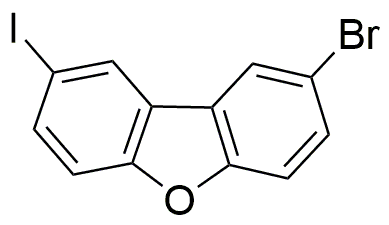2-Bromo-8-iododibenzofuran is widely utilized in research focused on:
- Organic Synthesis: This compound serves as a key intermediate in the synthesis of complex organic molecules, particularly in the development of pharmaceuticals and agrochemicals.
- Material Science: It is used in the creation of advanced materials, such as organic light-emitting diodes (OLEDs), due to its unique electronic properties.
- Biological Research: Researchers employ this compound in studies related to cellular processes and signaling pathways, helping to uncover mechanisms of disease.
- Photochemical Applications: Its ability to absorb light makes it valuable in photochemical reactions, which are essential in developing new energy solutions and photonic devices.
- Environmental Chemistry: The compound is investigated for its potential in environmental remediation processes, aiding in the breakdown of pollutants.
Informations générales
Propriétés
Sécurité et réglementation
Applications
2-Bromo-8-iododibenzofuran is widely utilized in research focused on:
- Organic Synthesis: This compound serves as a key intermediate in the synthesis of complex organic molecules, particularly in the development of pharmaceuticals and agrochemicals.
- Material Science: It is used in the creation of advanced materials, such as organic light-emitting diodes (OLEDs), due to its unique electronic properties.
- Biological Research: Researchers employ this compound in studies related to cellular processes and signaling pathways, helping to uncover mechanisms of disease.
- Photochemical Applications: Its ability to absorb light makes it valuable in photochemical reactions, which are essential in developing new energy solutions and photonic devices.
- Environmental Chemistry: The compound is investigated for its potential in environmental remediation processes, aiding in the breakdown of pollutants.
Documents
Fiches de données de sécurité (FDS)
La FDS fournit des informations de sécurité complètes sur la manipulation, le stockage et l’élimination du produit.
Spécifications du produit (PS)
Le PS fournit une description complète des propriétés du produit, notamment sa composition chimique, son état physique, sa pureté et les exigences de stockage. Il détaille également les plages de qualité acceptables et les applications prévues du produit.
Certificats d'analyse (COA)
Recherchez des certificats d'analyse (COA) en saisissant le numéro de lot du produit. Les numéros de lot et de lot se trouvent sur l'étiquette d'un produit, après les mots « Lot » ou « Lot de fabrication ».
Numéro de catalogue
Numéro de lot/série
Certificats d'origine (COO)
Ce certificat d'exploitation confirme le pays dans lequel le produit a été fabriqué, et détaille également les matériaux et composants utilisés et s'il est issu de sources naturelles, synthétiques ou autres sources spécifiques. Ce certificat peut être requis pour les douanes, le commerce et la conformité réglementaire.
Numéro de catalogue
Numéro de lot/série
Fiches de données de sécurité (FDS)
La FDS fournit des informations de sécurité complètes sur la manipulation, le stockage et l’élimination du produit.
DownloadSpécifications du produit (PS)
Le PS fournit une description complète des propriétés du produit, notamment sa composition chimique, son état physique, sa pureté et les exigences de stockage. Il détaille également les plages de qualité acceptables et les applications prévues du produit.
DownloadCertificats d'analyse (COA)
Recherchez des certificats d'analyse (COA) en saisissant le numéro de lot du produit. Les numéros de lot et de lot se trouvent sur l'étiquette d'un produit, après les mots « Lot » ou « Lot de fabrication ».
Numéro de catalogue
Numéro de lot/série
Certificats d'origine (COO)
Ce certificat d'exploitation confirme le pays dans lequel le produit a été fabriqué, et détaille également les matériaux et composants utilisés et s'il est issu de sources naturelles, synthétiques ou autres sources spécifiques. Ce certificat peut être requis pour les douanes, le commerce et la conformité réglementaire.


